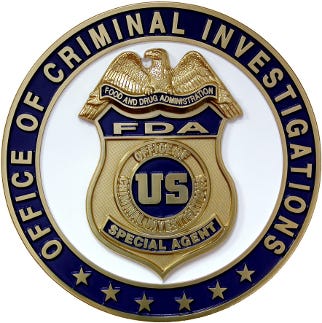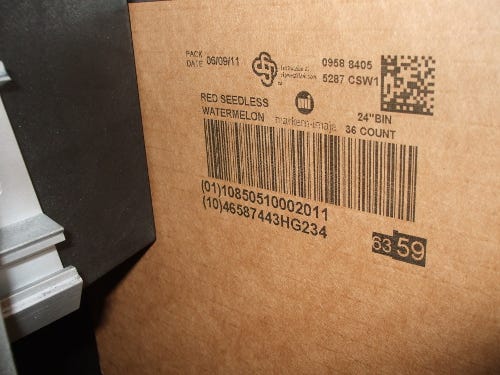Food safety law advances role of traceability
January 29, 2014

FDA criminal investigations badge
The most sweeping change to U.S. food safety laws in 70 years was enacted on Jan. 4, 2011, with passage of the Food Safety Modernization Act (FSMA).
It was not an easy birth.
Just two days prior to passage by the Senate, it was pronounced dead by both proponents and detractors alike. A last minute briefing by the CIA on al-Qaeda's plan to attack the food supply was taken seriously by Congress. With the recent death of al-Qaeda leader Osama bin Laden, one could argue the future impact of the group, but if you or your customers are in the food industry, the serious impact of FSMA is definitely not debatable.
Before delving into the requirements of FSMA, it's important to understand the law's goals. Approximately 75 percent of FSMA deals with documenting processes and inventory; and it has implications for both food safety and food security.
Food safety is primarily interested in protecting the population from intended and unintended bio-hazards.
Food security is primarily a law enforcement activity aimed at stopping intentional harm and locating the perpetrators. Neither of these purposes is well served by the "recall it all" mentality of the past, and FSMA seeks to end that approach.
Packaging's involvement
The requirements of FSMA are additional, not a replacement. That means any other existing requirements—such as nutritional info or Country of Origin Labeling (COOL)—remain in place.
FSMA and the previously passed FDA Bioterroism Act (FDA 306) have major direct and indirect effects on two types of packaging and, more specifically, labeling:
1. Packaging that touches food, such as sleeves and brites (empty cans).
2. Outer packaging as shipped to or received by another business, such as cases and super-sacks.
Let's look at each type, starting with packaging materials that touch food.
Essentially, if a packaging material touches food it is treated as food in FDA 306. So when bottles, caps, brites, lids, sleeves, bags and more touch food, they become food, from an FDA perspective. (Several federal agencies are involved in food safety issues but the primary ones are FDA and USDA. This article covers the FDA regulations because they cover the largest part of the food supply and, under FSMA, are the "de facto" governing agency. If you're in meat packaging, you'll be covered by USDA, but the same principals apply.)
The implications are that food-contact packaging products must be lot-controlled and that lot information and other data must be collected at the food processing plant's receiving dock. That lot must then be tracked as it is used with product—and in such a way that, if the plant is later provided a finished-goods lot number, the plant can back track the specific packaging vendor's lot numbers that ended up in that finished good.
While not fun, it sounds simple enough—at first pass. As with the U.S. tax code, the devil is in the details. An example will expose a bit of that "devil."
Assume we have a tomato canning operation that has a conveyor buffer that leads into the canning machine. As the buffer begins to empty, we add additional cans. A similar operation occurs with the lids. As we produce the canned tomatoes, we assign it a finished-goods lot. The problem is obvious—if the canning and lid machines intake buffers are continually refilled, which can lot and lid lot were used to make the finished-goods lot?
While collecting the initial data of lot numbers was easy enough, doing the reverse calculations to find can lots and lids is not. One solution is to use software such as Mobia's blend module, which allows for the non-sequential feeding of random lots into the blend areas, (in this case, the canning machine), along with the non-sequential removal on the other end. It even allows for the "emptying" of buffers. All the traceability heavy lifting is handled by the software.
Can a manufacturer do all this tracking on paper? Sure. You can also do all of your accounting that way, but issues such as cost, time and accuracy are against doing either without software.
Is all this overkill? Probably not. Food is a soft target for terrorism. And even the best of companies can have unexpected problems. (Remember ConAgra's peanut butter recall? Rain water with bird and/or rat droppings dripped through a leaky roof into the plant and caused a Salmonella contamination.)

Outer case traceability
The second type of packaging impacted by FSMA is outer packaging as shipped between businesses.
The requirements of labeling on outer packaging shipped between businesses are just as real but somewhat indirect. To shortcut to the end effect—lot numbers or manufacturing dates are required. The receiver is required to collect information such as lot numbers, manufacturing date or expiration date of the lot, and size of containers, at the receiving dock. The choice is for the supplier to provide that information on the outside of the container or force the receiver to disassemble the containers to collect the data. Obviously, the latter never happens.
The receiver then has to be able to track that product through any production and shipment where they, in turn, must relay that same level of information to their customer.
And this helps how?
Conventional traceability was built on the blunt and over-reaching "recall it all—more is better" principal. And while that sounds safest at first, we now know that it is not. No detective would ever prefer a phone book of suspects, who may or may not be connected to the case, over a short list of suspects who certainly were connected. That is the reason the new laws require that only the lots actually used in production of a suspect finished-goods lot are reported and, specifically, you may not include lots that were not. Also, if an ingredient lot is suspect, only the finished-goods lot that actually contained that specific suspect lot may be identified.
Cost versus benefit
If your company had not previously given this information or collected it yourself, yes, there is a new cost of doing business.
However, there are some serious hard and soft paybacks that may accompany your efforts to meet this requirement. Two of the most obvious are the reduction in mock or actual recall costs and the reduction of waste through better stock rotation.
As mock recalls increase in frequency, the savings from software that can do an instant recall are obvious.
Traditionally, stock rotation is handled by some type of a FIFO (first in, first out) process. This only works if the process is rigorously followed—and that older inventory is always received prior to newer inventory of the same type and the inventory is consumed prior to expiration.
Because we are now collecting manufacturing dates instead of delivery dates, good software will turn "hoped for" FIFO into realized FEFO (first expiration, first out), which automatically rotates stock and provides aging inventory reports.
In conclusion, FSMA may add costs for some companies, but in most cases the costs will be offset by improved productivity.
Author Dave Miller is product manager for Mobia Solutions. He is a recognized industry expert, lecturer and writer on inventory, manufacturing and traceability for the food and beverage industries. You can reach him at 864-288-7970 x2; or visit http://mobiasolutions.com
Key indicators to improve traceability compliance
How can you prevent a supply chain compliance crisis? By knowing current system performance and stability. Process-based analytics enables operations to monitor, quantify and improve processes managed by traceability systems, ensuring compliance and reducing risk through increased visibility.
What are the appropriate parameters to track? Multiple food safety and traceability compliance studies from the Aberdeen Group highlight four distinct key performance indicators (KPIs):
1. Production compliance
2. Overall equipment effectiveness (OEE)
3. On time and complete shipments
4. Response time to non-conforming shipments
![]()
Real-time tracking data chart histogram
Aberdeen indicates that these KPIs "provide a holistic measure of success in any organization, but are especially telling when examining the success of a food safety and traceability initiative." Production compliance and the speed of traceability directly impact food safety.
Operations can use process-based analytics to monitor and evaluate the response time to non-conforming shipments and make improvements that maximize compliance. The report in Figure 1 uses a histogram and control chart to analyze compliance performance. The CPK = 1.63 in the histogram indicates a highly capable process. However, the control chart reveals several signals that indicate something has changed in that process and further investigation is warranted. If the root cause to this process disruption can be identified, the process can be further improved. The company will now be able to respond more rapidly to non-compliant shipments, reducing risk and costs.
Management can also deploy dashboards to provide visibility for any parameter that needs real-time tracking. Alerts enable timely response to system failures and, when combined with trend analysis, support well-informed, proactive management decision making.
Author Jeffery Cawley, vp industry leadership, Northwest Analytics (www.nwasoft.com), can be reached at [email protected] or 503-224-7727 x112.
.
About the Author(s)
You May Also Like


